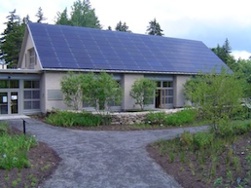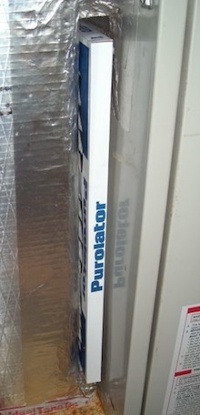What Are the Best Green Building Products?

 Mirror, mirror, on the wall, what’s the greenest product of all? You can find lists of the best green building products all over the web, and many sites update them annually. When looking for hot green building products, you have so many choices:
Mirror, mirror, on the wall, what’s the greenest product of all? You can find lists of the best green building products all over the web, and many sites update them annually. When looking for hot green building products, you have so many choices:
Mirror, mirror, on the wall, what’s the greenest product of all? You can find lists of the best green building products all over the web, and many sites update them annually. When looking for hot green building products, you have so many choices:
- Photovoltaic system (a.k.a. solar panels)
- Geothermal heat pump (more appropriately know as ground source heat pump)
- Programmable thermostat
- Tankless water heater
- Ductless mini-split heat pump
- Spray foam insulation
- Smart power strip
The list goes on and on, and I’ve mentioned what are probably the ones that have had the most sex appeal over the past decade. A lot of green homes have the products I listed above. But if you’re building a new home, fixing up an existing home, or running a business and trying to be green, where do you start? Although the answer to my question in the title isn’t so easy, I do have an easy answer to the this question:
Think systems first, then products!
I’ve tried to hammer this point home in many, many articles here, but it bears repeating. It’s not the product; it’s the process! I’ve seen solar water heaters installed on homes that were  about to fall down, but hey, the homeowner got the tax credit and the solar company made another sale. I’ve seen 20 SEER air conditioners installed on crappy duct systems that probably negate all the extra efficiency in the box (i.e., the equipment). I’ve seen spray foam insulation that wasn’t installed properly so they homeowners weren’t getting anywhere near what they paid for.
about to fall down, but hey, the homeowner got the tax credit and the solar company made another sale. I’ve seen 20 SEER air conditioners installed on crappy duct systems that probably negate all the extra efficiency in the box (i.e., the equipment). I’ve seen spray foam insulation that wasn’t installed properly so they homeowners weren’t getting anywhere near what they paid for.
If you want green, you’ve got to look at systems first, then products. Heating and cooling systems, no matter what type, have to be able to deliver the goods, and that means paying as much attention to the distribution system as to the box. Tapping into ‘free’ solar energy with photovoltaic modules requires making the home energy efficient so you’re not just generating energy that gets wasted.
That said, I will give you some specific advice about going green. Here are my top 5 things to consider if you want a green home, or rather, to be green in your home.
- Live close to where you work. Location efficiency can be more important than energy efficiency.
- Choose a not-so-big house. Sarah Susanka has turned this phrase into a career, and smaller is greener. Also, multifamily housing (condos, townhomes…) is greener than single-family detached housing because you have less building envelope.
- Improve the building envelope first. You may decide not to go all the way to Passive House levels of insulation and air-sealing, but you want to minimize the amount of heating and cooling that your home needs. Remember, your building envelope is the cup; the HVAC system is the faucet.
- Reduce water usage. Some ways you can do this are with an efficient hot water distribution system, low-flush toilets, and a greywater system.
- Take advantage of natural heating and cooling. Design passive solar features into the house to capture the Sun’s heat in winter and keep it out in summer. Use cross-ventilation, with help from fans, for cooling.
I’m not saying that products aren’t important. I built a green home, and one of the most excruciating aspects of doing it was deciding which products to use. Two great resources for product information are Green Building Advisor and Building Green. I write a weekly article for the former, and they have tons of other good info there. Become a GBA Pro, and you have access to an incredible wealth of product info, green building details, and much more. The latter is Alex Wilson’s company, and they publish the ultimate green product directory, GreenSpec.
Get good green products. That’s important. But don’t waste them by just throwing them at a house and thinking that you’ll end up with a green home just because you put solar panels on the roof. Remember:
Think systems first, then products!
Related Articles
A High Performance Home is Defined by the Process, Not the Products
It’s Not Just the Box – High Efficiency HVAC Includes the Ducts
More Important than Home Energy Efficiency – Location Efficiency
This Post Has 7 Comments
Comments are closed.

Hear, hear! As a building
Hear, hear! As a building shell guy, thanks for #3. I hate seeing the results of ‘spray and pray’ or ‘blow and go’ that happen in the insulation industry. I call myself a home performance guy instead. The installation makes ALL the difference. Just ask one of my customers who had his soffits filled by a cheap guy and now has mold.
You don’t have to “spray
You don’t have to “spray and pray” if you build with SIPs. SIPs give you a consistent R value and a tight building envelope. EPS SIPs, in particular are completely recyclable. You can’t say that for spray foam.
Allison – Right on! I have
Allison – Right on! I have been in the Green Building Product business for years and I agree that the envelope and energy saving measures should be done before investing in products and systems.
Thanks! I’ve been waiting for
Thanks! I’ve been waiting for an article like this. I am also wondering about best composting toilets I’ve been looking at Sunmar. For solar, Westinghouse seems easiest for D-I-Y people. Now if you are in Louisiana unless they have changed their sanitation code within the last decade, this State has no definition of Greywater. Everything must be captured/processed, etc. Now for the big question to any and all? I’m in initial stages of research about building reasonably green for lower income. If Habitat for Humanity will work wth me great, if not I am looking at the feasibility of moving forward with my own Non-Profit in Texas. Will be Building green energy efficient homes with Solor to handle at least 50% minimum needs of the home owners. So if any body has any info/contacts/organizations about green building in the State of Texas Please let me know? Just reply and I will get the email, Thanks to EV, and to all!
Thanks Allison. I am a
Thanks Allison. I am a building materials supplier often called on to help with materials selection on green homes. I think that your blog touches upon the biggest problem in an owner meeting their sustainability goals; over emphasis on prouct, not performance of the system. I spend a lot of time educating builders and owners on how to assess a specific product. Ultimately the problem is with the process, not the products. Rather than picking products, one should choose their performance goals and fit a product to that. Also, assessing products on an attribute or a couple of attributes often misses the mark. when it comes down to it, the only two things we need to assess is a LCA for total energy, and toxicity measured for individual health and toxicity of the manufacturing process. When I started looking at products in this way I had to come to the realization that most of the products I make my living selling are not the best choices for a green home, even if their performance may be stellar.
Nate A.:
Nate A.: Moldy soffits. Yum!
Tom M.: I do like structural insulated panels (SIPs). I built a house out of them. But the message of this article applies to them as well. I’ve heard of bad SIP installations, too.
Steve K.: Thanks! Green building products are certainly important; they just need to be incorporated properly with good processes.
Ken B.: Check out the articles I wrote about the composting toilet and greywater system I put in the house I built. There’s a whole lot going on in Texas. If you just google ‘HERS Texas’ or ‘green building Texas’ or something similar, you’ll find a lot of links.
T.C. Feick: Thanks. That’s a great point about how to analyze products with Life Cycle Analysis (LCA) and toxicity. I haven’t covered that yet here, so it’s on my list now.
energy conservation is the
energy conservation is the biggest green product.
when a homeowner calls me & says I want to build green..I almost cringe.
there are so many products that claim to be green, but the only green thing about them is the extra green you spend to get them.
I read an article by Joe L. about greenwashing & how labels can be misLEEDing. I’m in total agreement.
building an efficient house that has a small carbon footprint and is affordable for the homowner to build and live in for the next 50 years..thats what it is all about..in my pov.
sizing the hvac instead of bigger is better, improving the building envelope, reducing duct leakage..same products..better application.
just my two cents worth!
good article.